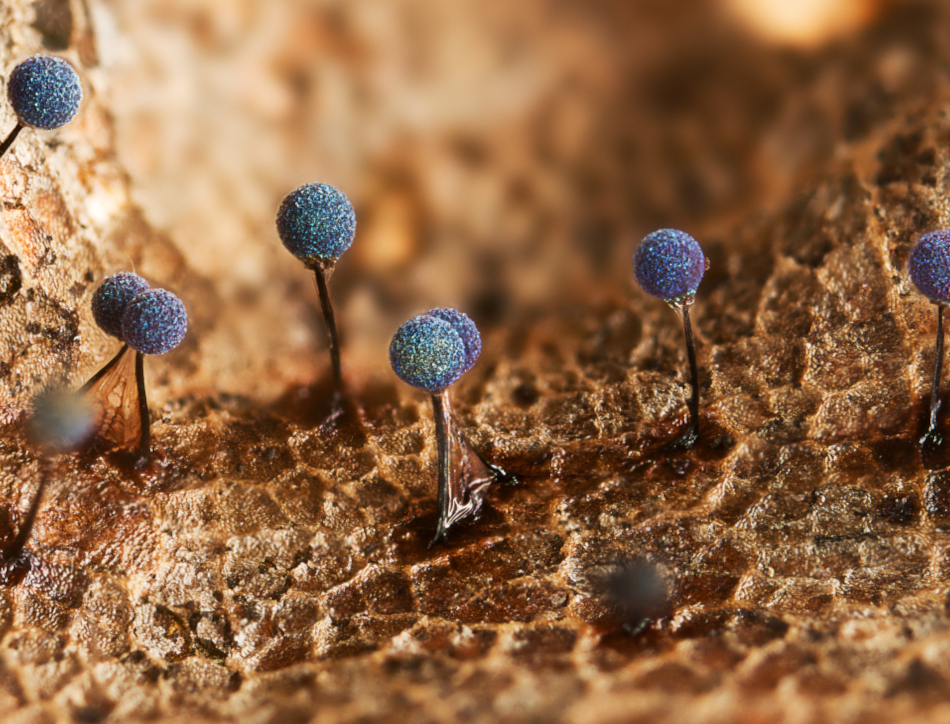Finalists 2023
After a 4-year absence due to the global pandemic, the competition returned in 2023 to showcase the amazing images our scientists captured in the areas of Astronomy, Behaviour, Earth Science and Climatology, Ecology and Environmental Science, and Microimaging. Our winners and runners-up can be found below.
We are grateful to our judges Professor Jon Blundy FRS, Professor Duncan Mackay and Professor Ulrike Muller for whittling several hundred entries down to our 10 finalists, and hope you enjoy seeing the nebulas, fault lines and ocean creatures they found along the way.
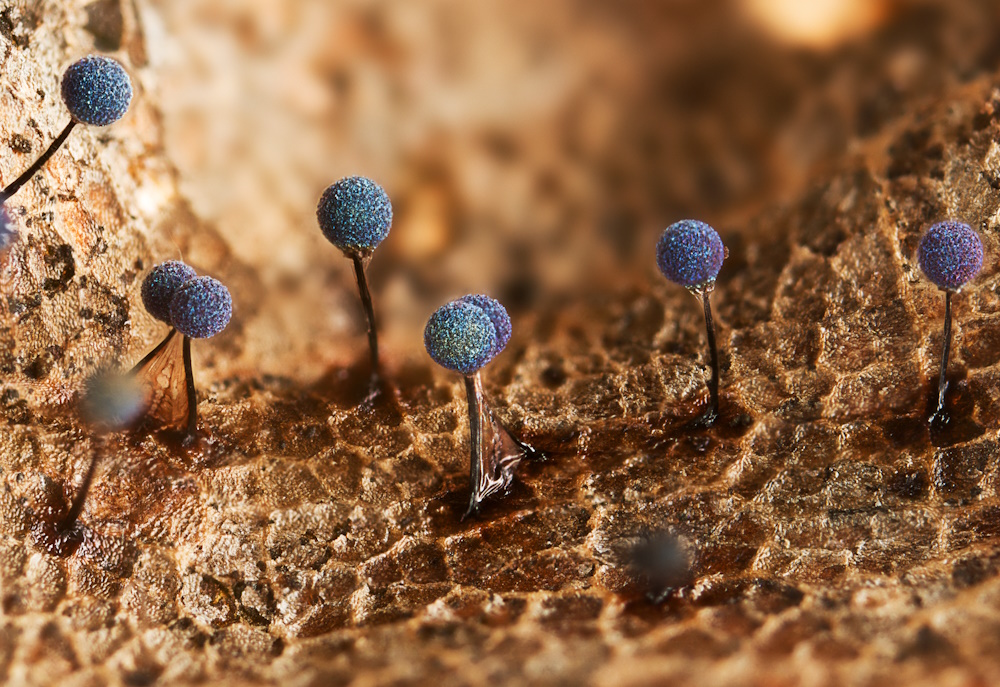
Competition winner 'Martian landscape' by Irina Petrova Adamatzky. This photo shows a specimen of Lamproderma scintillans, an exceptionally fascinating microorganism firmly adhered to an autumnal leaf in Somerset, UK. Classified within the taxonomic group Myxomycetes, or plasmodial slime moulds, Lamproderma scintillans exemplifies a captivating amalgamation of traits bridging the realms of both the plant and animal kingdoms. The slime mould exhibits a striking array of hues, ranging from earthy browns, fiery reds, and lustrous bronzes to occasionally a mesmerizing steel-blue iridescence, mirroring the vibrant palette of the surrounding deciduous landscape. This species has been documented in 64 countries, and its habitat spans a diverse range of environments, including locations with disturbed and preserved ecosystems, riparian forests, the Atlantic forest, and savannas. Lamproderma scintillans is frequently encountered on deceased leaves, airborne leaf litter, and decomposing tree trunks. The specific image at hand underscores the remarkable capacity for adaptation and the intricate ecological interactions exhibited by this enigmatic organism, particularly within the context of the autumnal season. It provides a valuable glimpse into the dynamic and ever-evolving relationship between Lamproderma scintillans and its environment, shedding light on the complex web of life that thrives within terrestrial ecosystems. I used a Sony Alpha A7R IV camera with a Laowa 25mm f2.8 2.5-5x Ultra Macro lens to capture the image, ISO 50, 1/125sec, f/16.
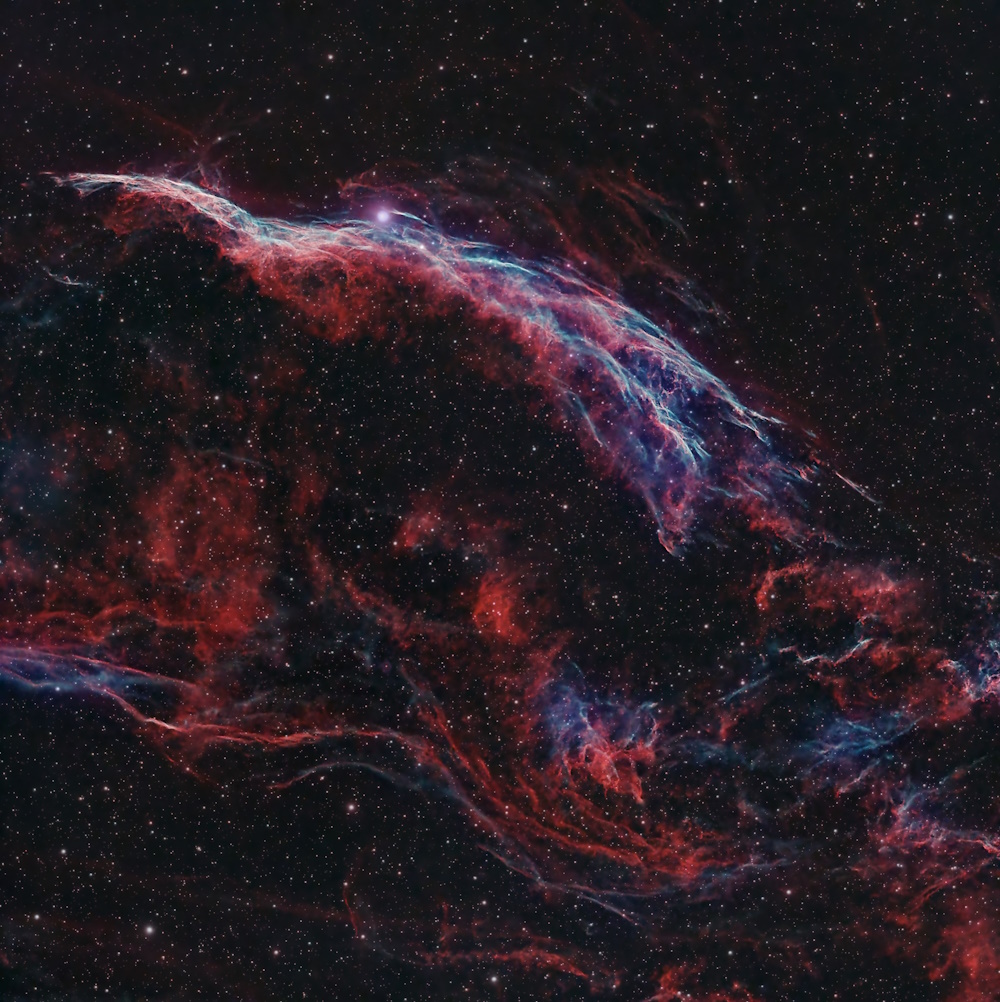
Astronomy winner 'The Western Veil Nebula' by Imran Sultan. About 10,000-20,000 years ago, a star much more massive than our Sun exploded in a supernova. The result was the Veil Nebula, a magnificent supernova remnant found in the Cygnus constellation. Despite being over 2000 light years away, the angular size of the Veil in our sky is several times larger than the Moon (Fesen et al. 2018). My picture shows a part of the nebula known as the Western Veil. I imaged the Western Veil over two nights from the city skies of the Chicago suburbs. I was able to overcome the extreme light pollution, a growing problem that is detrimental to stargazing and makes deep sky astrophotography nearly impossible, by using a special filter which only allows certain wavelengths of light to pass through: specifically, the wavelengths corresponding to H-alpha and O-iii emission. These wavelengths are commonly emitted by the hydrogen and oxygen gas (the red and blue colors in the picture, respectively) in emission nebulae. My picture contains over four hours of total imaging time and is a "stack" of 52 individual 300-second sub-exposures. Equipment: ZWO ASI533MC Pro camera, SVBONY SV503 80ED refractor telescope, focal reducer, Optolong L-Ultimate filter, Astronomy Winner ''Star Adventurer GTi, ZWO 30mm f/4 guidescope, ASI120MM Mini guidecamera, ASIAIR Pro Processing: Astro Pixel Processor (stacking, light pollution removal), PixInsight (BlurXTerminator, NoiseXTerminator, masking/stretching tools (Bill Blanshan), etc.), StarNet (starless and stars blend), Adobe Photoshop: levels, curves, color correction
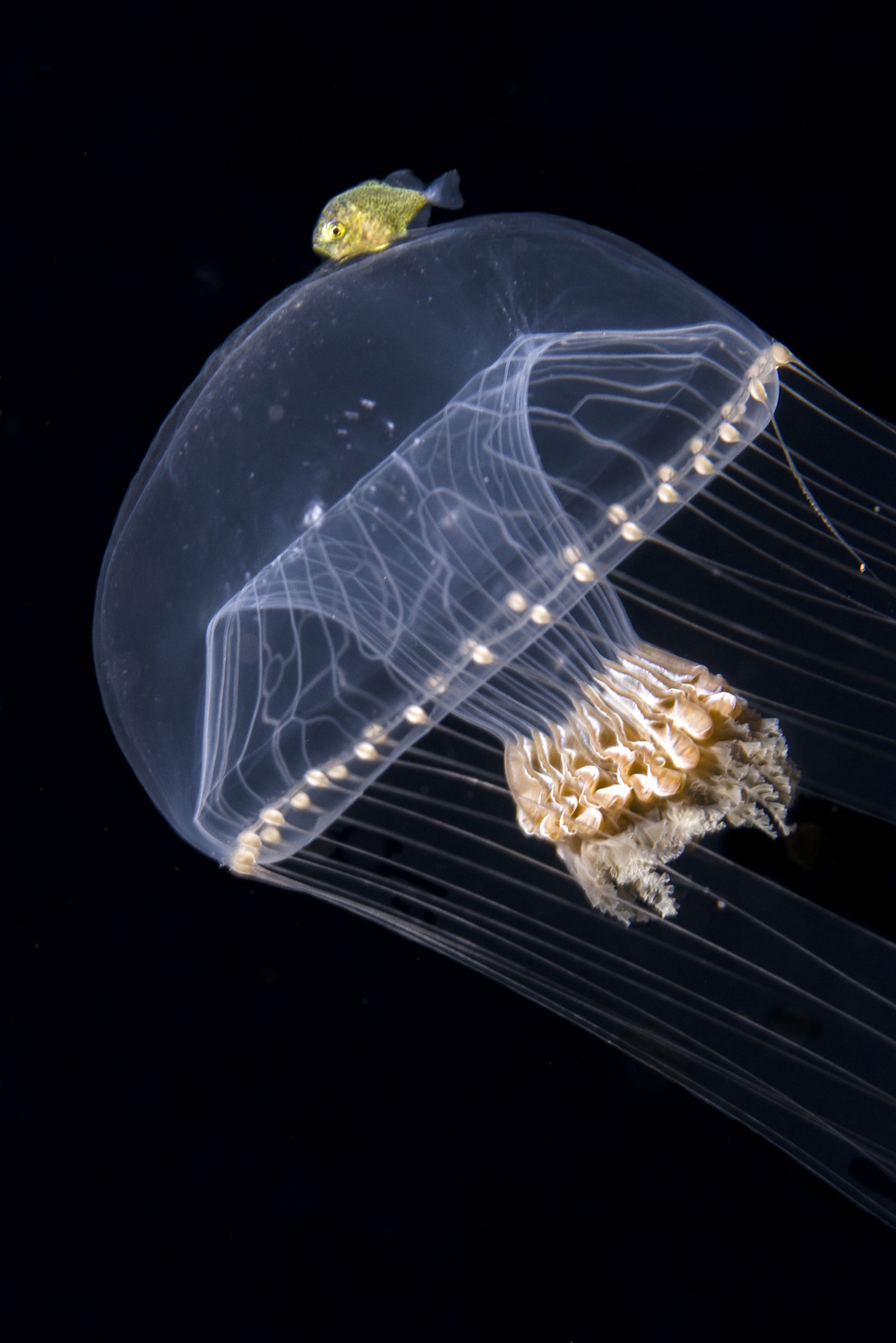
Behaviour winner 'Nightly elevator' by Tom Shlesinger. Every night, the largest migration in the world takes place in the ocean. As the night falls, many organisms move up from the great depths of the ocean towards the sea surface. They engage in this vertical migration mostly to access food while avoiding daytime predators. Before the crack of dawn, they descend back down. Many small or juvenile animals are hitching a ride on jellyfishes, which provides a unique “elevatorâ€: Not only that these juveniles can peacefully rest while the jellyfish transports them above, but they also get some protection. With their stinging cells, the jellies protect their hitchhikers from predators that will avoid getting too close. This photo was taken with a Sony a7RIII camera and a 90mm lens. Minor post-processing using Photoshop CS6 (Crop, Contrast, Levels, Vibrance).
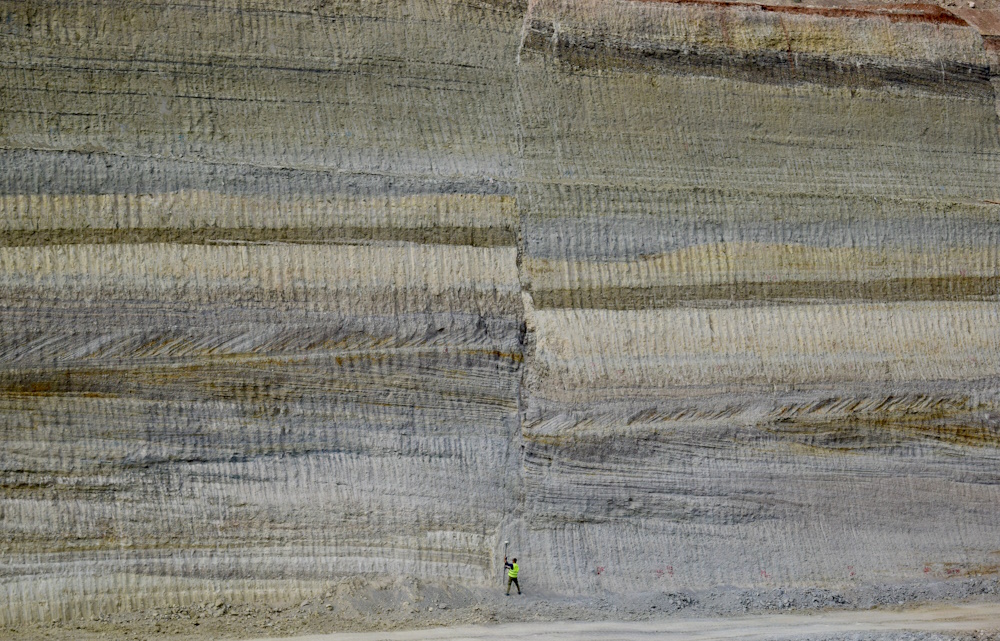
Earth science winner 'A crack in time' by Chia-Hsin Tsai. The photo was taken during an undergraduate field course at the Corinth Canal in Greece in September 2022. The image depicts a typical outcrop, showcasing normal faults within extensional tectonics setting. The Corinth Canal sits in the centre of the neotectonic depression and cuts through numerous normal faults. These faults displaced the Middle to Late Pleistocene lacustrine and marine stratigraphy with evident sedimentary structures. The near-vertical fault plane indicates potential lateral movements as well. The canal was being excavated for expansion when this photo was taken, rendering the outcrop was fresh. Notably, a surveyor with a measuring tool was captured coincidentally as a great scale. Camera: Nikon D5300 at a focal length of 55mm, aperture f/6.3, ISO 630 and exposure of 1/640 second. Lens: 18-55 f3.5-6.5.' Minimal adjustments were applied via the iOS app Photos.
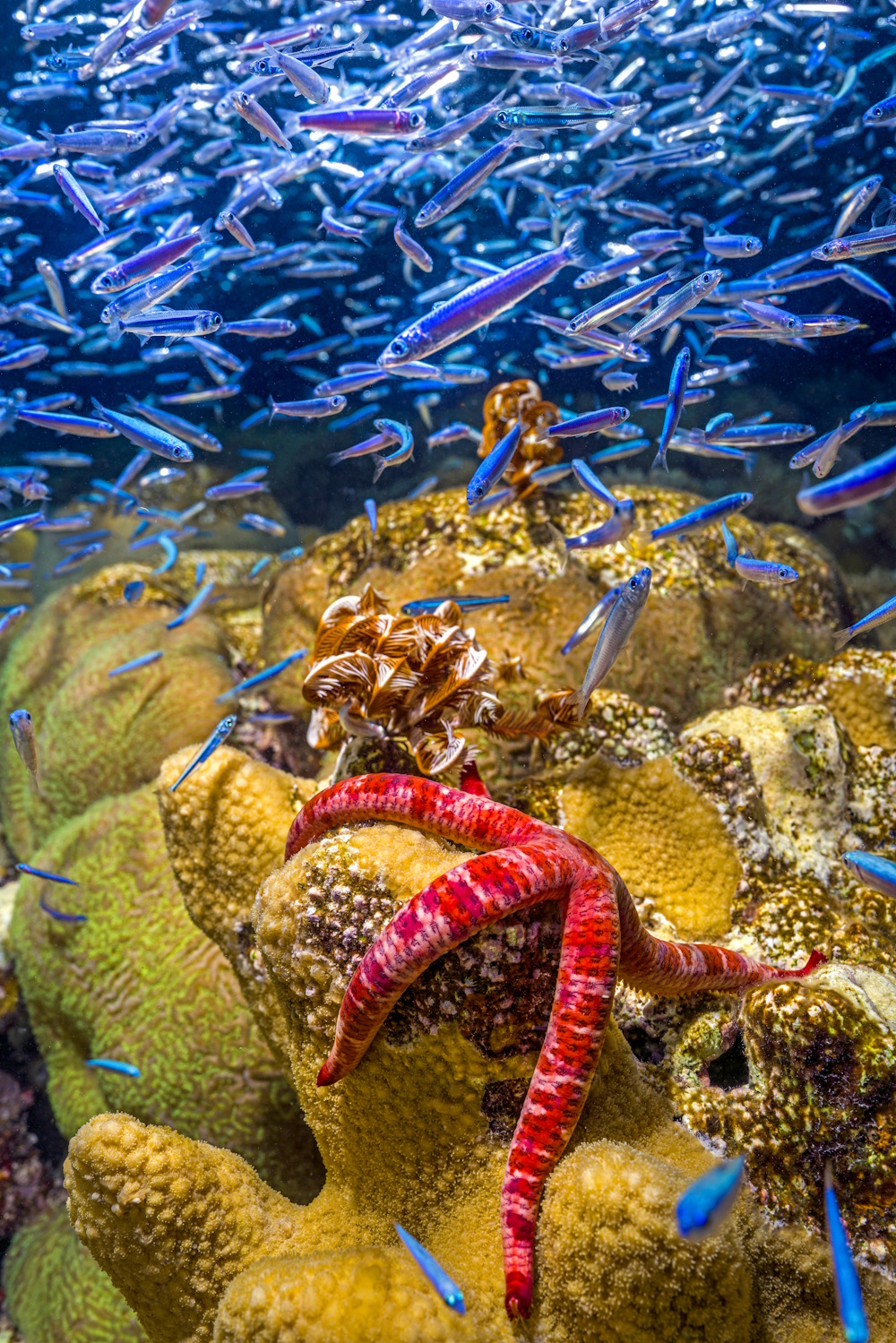
Ecology winner 'Star of the night' by Tom Shlesinger. What happens at a coral reef at night? Some fish go to sleep while other animals wake up and come out of their dens to forage. The seemingly busy life during sunlight hours continues, just with different actors. Here, a school of small fish running wild above a colorful reef and a sea star, which just came out of its den to forage. This photo was taken with a Sony a7RIII camera and a 16-35mm lens. Minor adjustments were made using Adobe Photoshop (contrast, levels, vibrance).
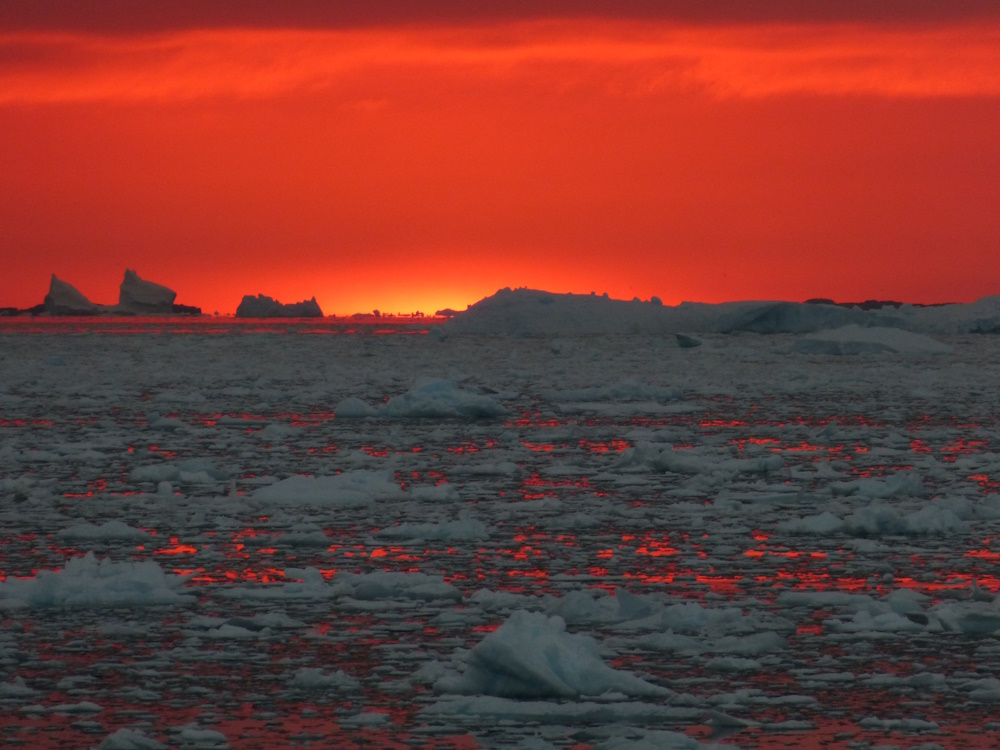
Earth science runner-up 'Burning through the frozen south' by Michael Meredith. Many have commented that Antarctica feels like a different planet; perhaps this is especially true during the fiery sunsets that can last for hours. Whilst on fieldwork at the Antarctic Peninsula in 2020, we watched the dying rays picking out gaps between ice floes, creating a landscape that seemed like lava. To us, it appeared emblematic of the rapid heating and drastic loss of ice that this part of Antarctica is now suffering. Photo taken with Panasonic Lumix DMC-FZ150; 1/125s, f/5.2, 108mm. No post-processing or filters applied.
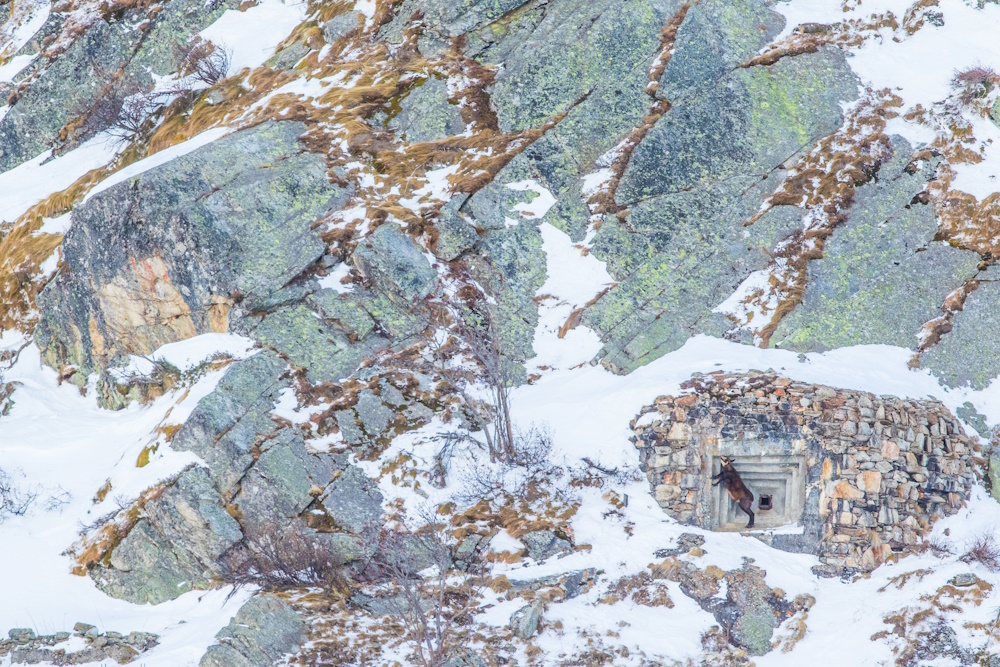
Ecology runner-up 'Post-war chamois' by Filippo Carugati. Over the last centuries, the Alps have been theatre of many conflicts since they represent natural and political borders among different countries. For this reason, many valleys host remains of past wars, from Medieval castles to trenches and fortifications from the World Wars. During a winter walk in Val Varaita (Western Alps), I spotted an Alpine chamois (Rupicapra rupicapra) licking the wall of a WWII bunker. This artificial build was perfectly camouflaged on the rocky pattern of the slope. This behavior is probably connected to the assimilation of mineral salts and diet integration during the winter season when food is rare. I captured this scene including the surrounding pattern of vertical rocks to emphasize the peculiarity of the moment: remains of a war past now are now peacefully reclaimed by nature. Canon 7d Mark II, EF300mm f/2.8L IS II USM +1.4x III, f11, 1/400, ISO 400. crop, levels adjustments
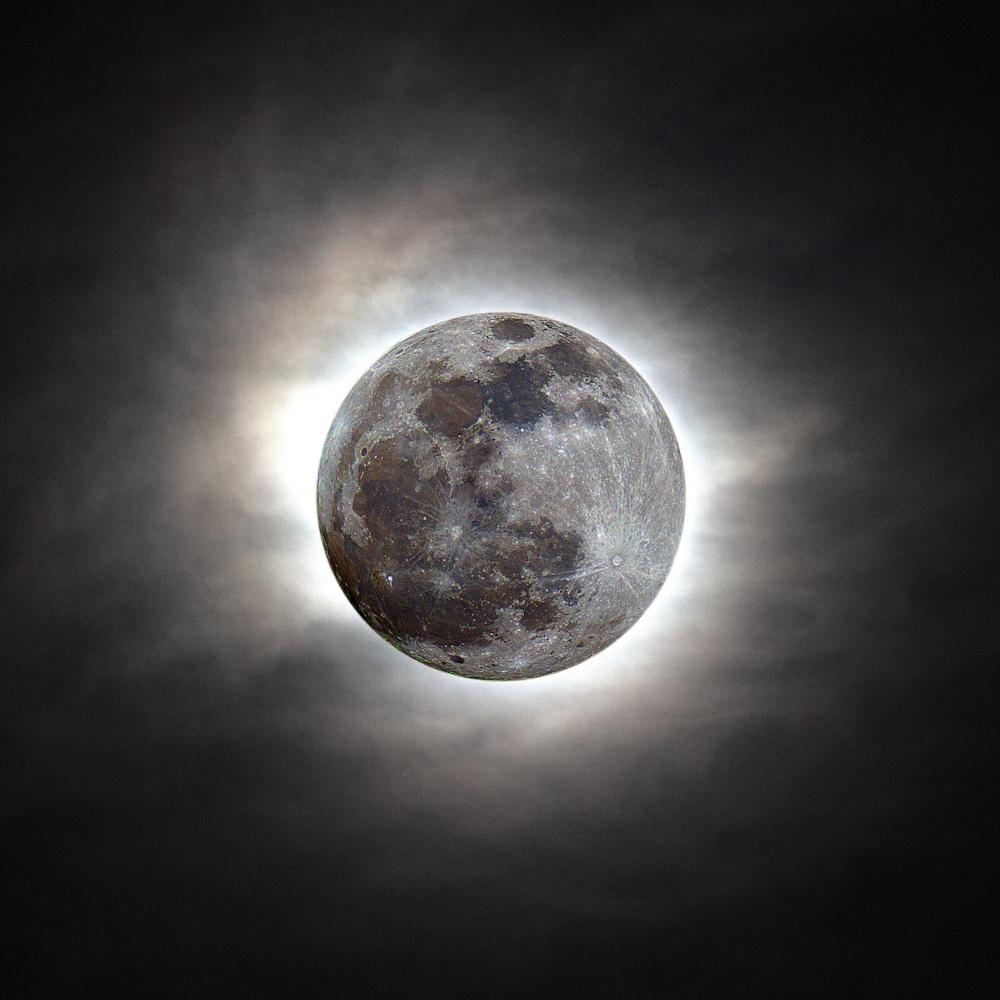
Astronomy runner-up 'Flower Moon on a cloudy night' by Imran Sultan. 'The May full moon is known as the Flower Moon, a name originating from the Algonquin peoples that marks the blooming of flowers during spring. This year's Flower Moon fell on a cloudy night when I photographed it from the Chicago suburbs. My picture is an HDR composite of images at two different exposures. To capture the bright moon, I shot dozens of very short exposures and combined them together; I edited the stacked image to show the details of the lunar surface, and to reveal the faint colors associated with the mineral content of the moon that are invisible to the human eye. The photo of the cloudy sky is a single longer exposure. I shot the photos on May 4, 2023, from Des Plaines, Illinois. The Moon is a stack of 41 photos at 1/400 sec ISO 100. The cloudy sky is a single exposure shot at 1/40 sec ISO 800. Equipment: Canon Rebel T5i, SVBONY SV503 80ED refractor, Star Adventurer GTi, ASIAIR Pro Processing: PIPP, AutoStakkert! (stacking), RegiStax (wavelets adjustments), Adobe Photoshop (combine photos in HDR composite, hue/saturation adjustments)
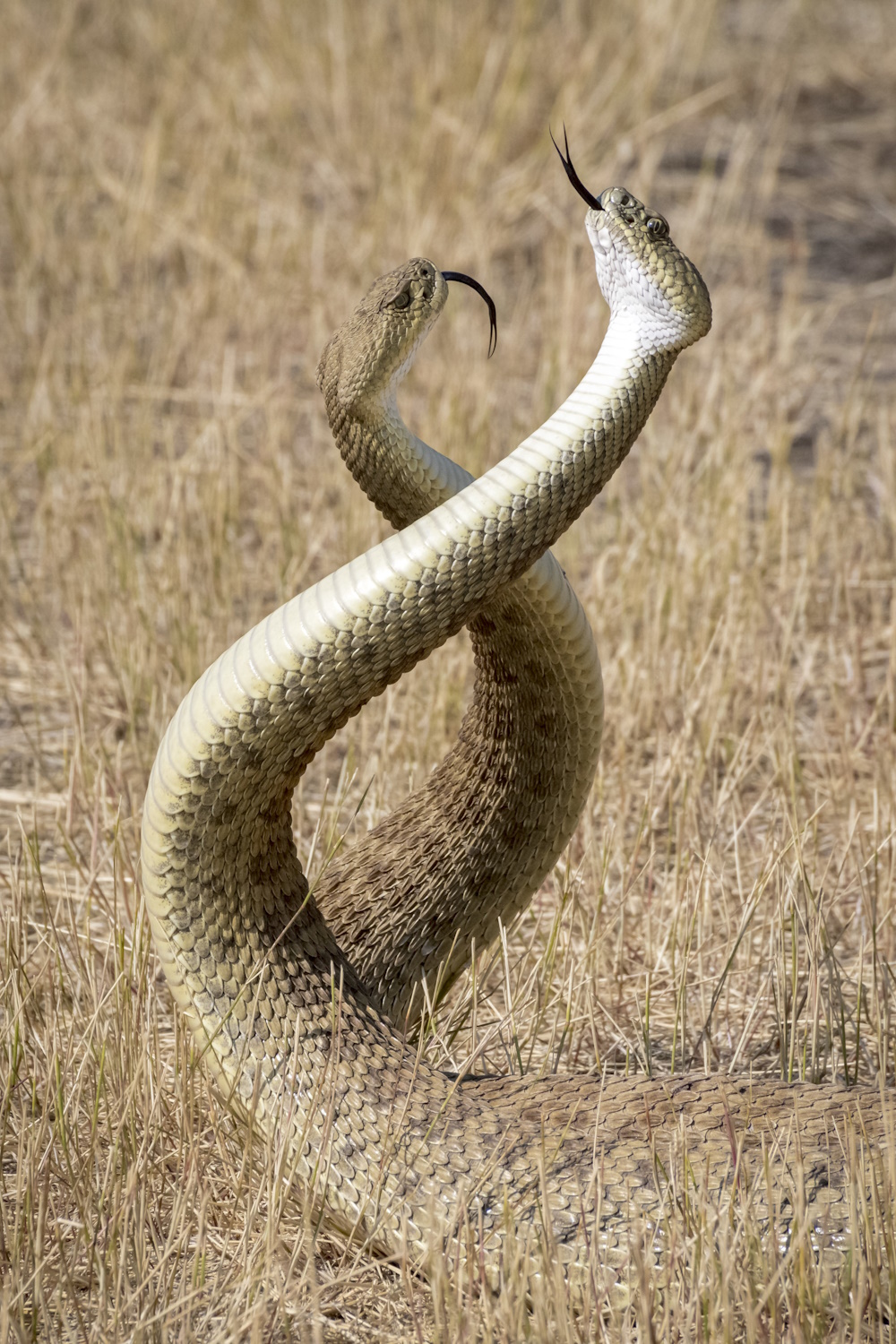
Behaviour runner-up 'Ssstandoff' by Gregory Funston. When digging dinosaurs in southern Alberta, Canada, prairie rattlesnakes (Crotalus viridis) are ubiquitous neighbours. Returning to camp from an excavation of a horned dinosaur, we were treated to a show by two very large (1.5 m, ~ 5 ft) males, tussling for dominance. Intertwining their necks, they would raise up off the ground and attempt to slam their competitor down. After a few minutes of intense battle, they separated and moved off, apparently unharmed. Despite their perception as violent animals, seeing two snakes interact like this is incredibly rare—perhaps a lesson for how we think of dinosaur behaviours. Nikon D850, 70–300 mm VR II @ 280 mm, f/16, 1/1250s, ISO 1600. Post-processing adjustments to exposure, contrast, sharpening, colour balance, and cropping.
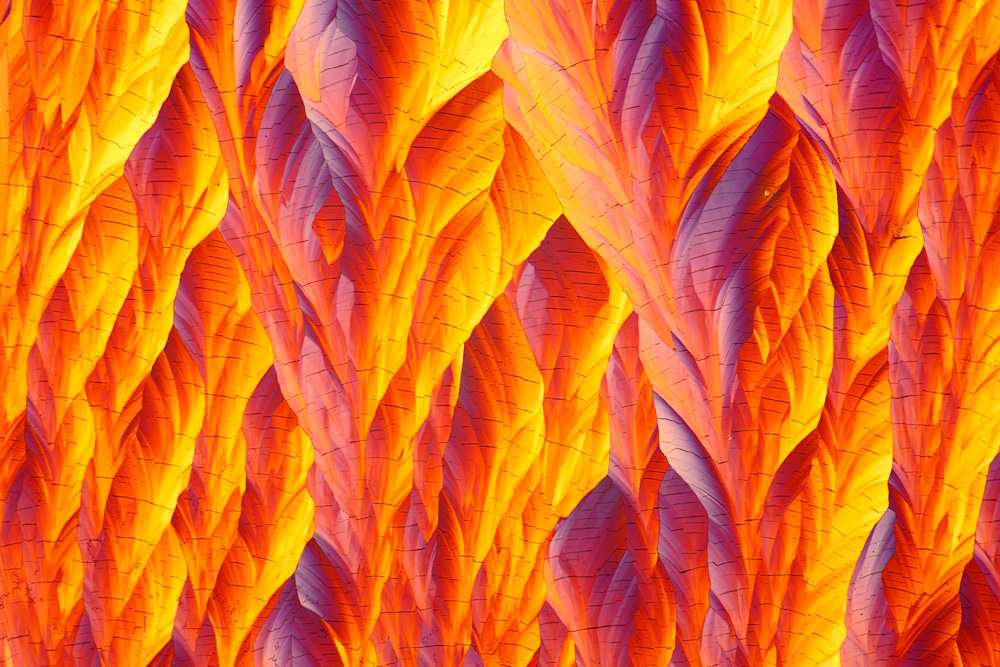
Microimaging runner-up 'Beacon of crystals in a wild forest' by Shyam Ulhas Rathod. The Image shows micro crystals of two chemical combinations Beta Alanine and L Glutamine showing the evolution of crystal patterns in process of crystallization of the chemicals.Technique used here is polarization ,equipment used were,Microscope MX21iLED by Magnus Opto and Camera used for Imaging is Sony a 6600 mounted on trinocular head with a 3d printed coupler). The colourful image was achieved using two polarizing filters with a cellophane retarder to bring up colors. Thin layer of the solution in 50-50 water-ethanol ,of the chemical combo was spread on a microscope slide and the crystallization process started in a few seconds after heating and cooling. The size of the photographed region is approx. less than 1mm on the longer side.The image not only shows the beauty at microscopic level but also may hold great potential for research in the field of crystallization to understand why particular chemicals have some distinct patterns and why such shapes evolve is a matter of great study and may hold a whole new window for science.

